Why do you see faces in unexpected places?
A house that looks like Hitler. . A jelly bean resembling Kate Middleton. These curious cases of famous faces in unexpected places are examples of “pareidolia”. This is when we spot familiar patterns in random data.


Humans are “hardwired” for recognising faces. This makes sense from an evolutionary perspective, says psychologist Rob Jenkins from the University of York. “If there’s a face nearby, there’s a mind nearby. That’s something that can potentially do you a lot of good or harm,” he says.
And face recognition starts early. “Babies who are nine minutes old seem to show a preference for face-like patterns,” says Rob. In tests, new-borns spend longer looking at patterns of dots and dashes which resemble two eyes and a mouth than at similar, non-face-like patterns.
It doesn’t take much visual evidence for us to see a face. A few dark patches roughly in the positions of eyes and a mouth are all we need.


But are we humans really so special?
A 2017 study found that sheep have the ability to recognise familiar human faces. Cambridge University researchers were able to train sheep to identify the faces of actors Jake Gyllenhaal and Emma Watson, former US President Barack Obama and ����ý newsreader Fiona Bruce.

Sheep trained to recognise celebrities
Sheep have shown they can recognise familiar human faces.
And while we are very good at recognising familiar faces, we are worse than we think at identifying unfamiliar ones. Researchers presented people with two photographs and asked if they showed the same person. They found an error rate of around 20%.
With faces we don’t know, subtle differences such as lighting, expression, make-up or hair style can really hamper our recognition skills.
And how good are we at recognising faces compared with machines?
The ����ý’s technology correspondent Rory Cellan-Jones says facial recognition software has been around for a long time but has not yet lived up to expectations. He says the more images you ask computers to process, the less accurate they tend to be. “There’s an extraordinary amount of variation in the images on which the computers are trained,” he says.
So who would win in a face recognition battle – humans or computers?
“It depends on the task,” says Rob Jenkins. “If it’s a human who knows the face they’re looking at, bet on the human every time. If it's a face that is unknown, there will be situations now where the machine has the edge.”
And Rob thinks that with technology changing so rapidly, it won’t be too long before we are outperformed entirely by machines.




The Curious Cases of Rutherford & Fry
-
![]()
Here are a dozen facts which will really get under your skin.
-
![]()
Why do humans faint but giraffes don't?
-
![]()
Why do non-ginger parents sometimes give birth to redheaded children?
-
![]()
Drs Adam Rutherford and Hannah Fry hunt for a true sphere.






















